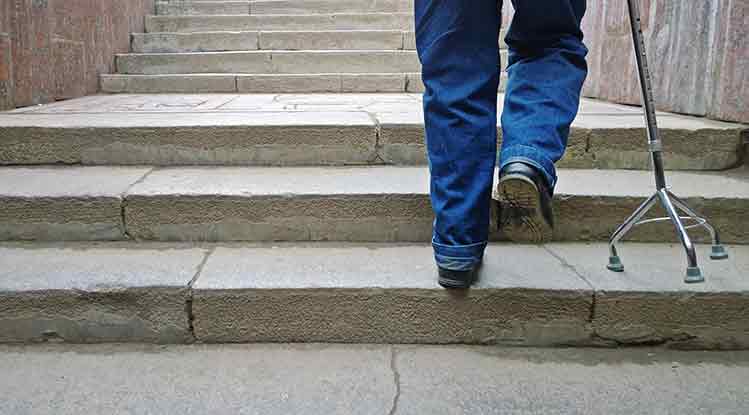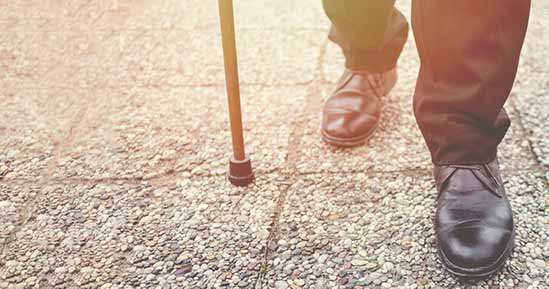Proper Use of Cane: 7 Mistakes to Avoid
If you have ever picked up a walking cane, it probably felt like second nature, and you were already aware of how to use it. It is this confidence that often leads people astray.
Using a cane may seem like the most natural thing in the world. However, more often than not, individuals are using their cane incorrectly.
Incorrect use means that they are either not gaining all the benefits of a cane or setting themselves up for injury.
To help you figure out the proper use of a cane, here are some of the mistakes that you may be making:
1. Holding Your Cane in the Wrong Hand
This is actually one of the more common mistakes to make.
This is because people tend to favor their dominant hand. Also, in case of an injury or surgery, individuals tend to hold the stick on the side of the issue.

What you need to do instead, however, is to hold the cane in the hand that is on the opposite side of the injury. It is this that will help you overcome any deficiency.
Having the device on the wrong side will actually not prove to be beneficial at all. After all, the point of the assistive device is to take the stress and pressure off of the injury.
2. Keeping Incorrect Timing with Your Cane
Think of your cane as your dance partner – both of you will need to have a matching rhythm if you are hoping to get anywhere. You have to match the movement of your weaker leg with the device.
This means leading with your weak leg. Whenever you take a step forward with your weak leg, you are going to need to carry the stick forward for that same distance.
Both the end of the cane and your weak foot should be parallel to one another.
Then, you will be able to put your weight on the device and take some of the burdens off your injured leg.
3. Letting Your Cane Drag When You Are Walking
It is a habit that many people have, letting whatever you are carrying drag behind you. After all, it can feel quite natural.
However, dragging it behind is not the proper use of a cane as it does not support you. Also, you will be less likely to use your device properly, every time you step with your weak leg.
What you should do, instead, is to keep your stick by your side, at all times.
This way, it is simply a case of swinging the cane forward when you need to.
4. Placing the Cane Too Far In Front
Just like keeping the cane in the back can be a problem, setting it down too far in front can also have negative consequences.
At the most, your stick should only be a few inches away from you, when you set it down on the ground.
Remember, the device is supposed to help you with your balance.
If it is too far away from you, you may end up overreaching and lose the same balance that is supposed to afford you.
5. Taking the Stairs Wrong
When you are taking the stairs, the process is a little different from when you are just walking around. Here, you lead with your strong foot.
For instance, imagine you are taking a step up. Then, you will need to put your strong foot on the first step.
Once you are properly balanced, then you should put both your weaker leg and then the cane on the step.

If you are going down the stairs, however, make sure to lead with your cane, followed by your weak leg, and then finally with your strong leg.
If there is a railing that you can hold onto, you should do so. In this instance, switch the device to the other hand as you hold onto the rail for support.
It is vital that you only take one step at a time when taking the stairs.
6. Not Having Good Posture
When putting weight on the cane, many people tend to develop a bad habit of bending over. This is a terrible posture for you.
When you do place your weight on the device, you should avoid either leaning forward or leaning too much to the side.
Instead, whenever possible, keep your back straight. This will help you to prevent backaches and many other corresponding issues.
7. Having a Wrong Kind of Cane
A cane can help you walk more steadily and compensate for a disability or injury.
But how about your assistive device? Is it the right type?
Single-tipped canes work well for most people. A quad cane provides better support but is a more cumbersome device to use.
Sometimes the handles aren’t shaped to distribute weight along with the hand and can even cause nerve compression in the wrist or palm.
Here you can read more on what kind of walking cane is the best for different situations.
Bottom Line
These are the most common ways that people misuse their device or have the wrong kind of cane. Now that you are aware of them, you can see that the proper use of a cane has many benefits.







